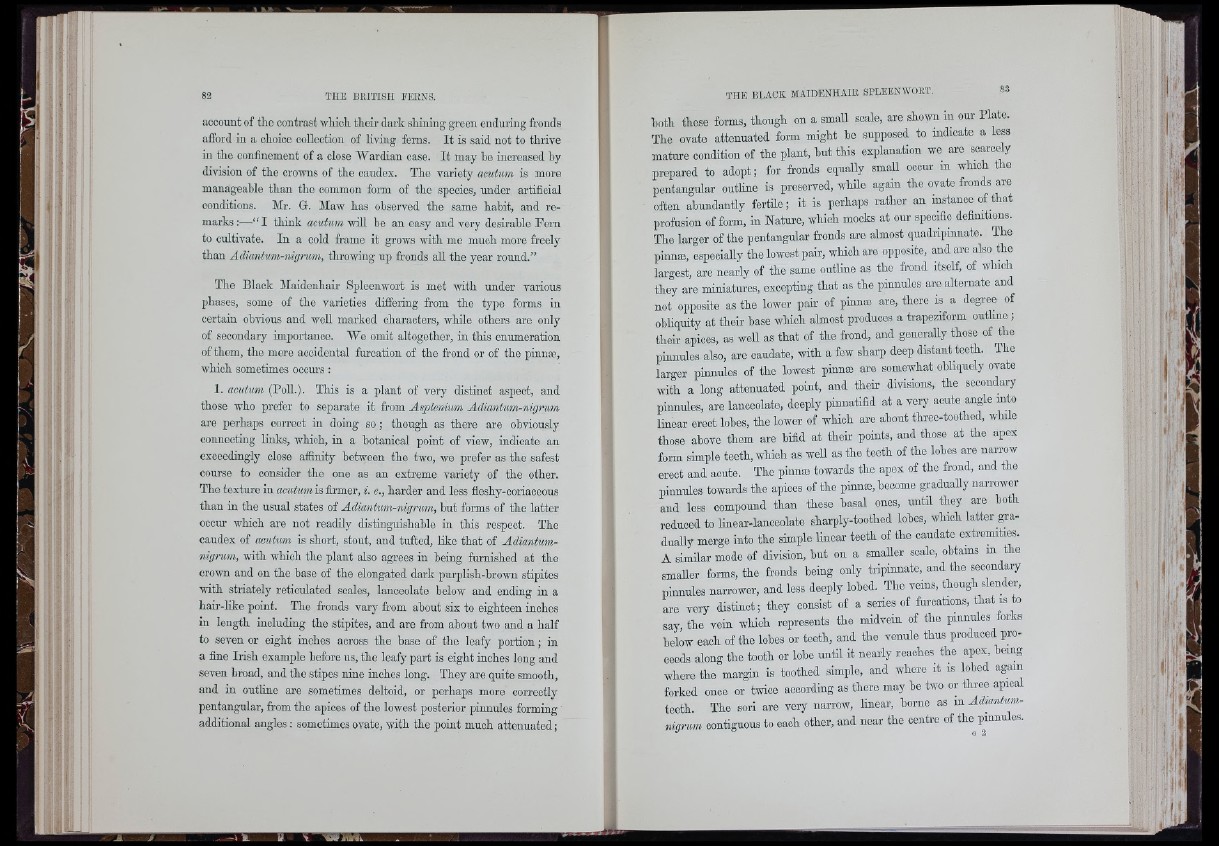
it
(■ I
li 5
i i ’ ’
1 "
f ;;
i-f ■
: i: r
;.ili
Ifi^
’ fi:-
| L
account of tlio contrast whicli their dark shining groon enduring fronds
afford in a choice collection of living ferns. It is said not to thrive
in the confinement of a close Wardian case. It may be increased by
division of the crowns of the oaudox. Tho variety acutimi is more
manageable than the common form of tho species, under artificial
conditions. Mr. G. Maw has observed the same habit, and remarks
:—“ I think acutum will be an easy and very desirable Foi-n
to cultivato. In a cold frame it grows with me much more freely
than Adiantum-nigrum, throwing up fronds aU the year round.”
The Black Maidenhair Spleenwort is met with under various
phases, some of the varieties differing from the type forms in
certain obvious and woU marked characters, while others are only
of secondary importance. Wc omit altogether, in this enumeration
of them, the mere accidental furcation of the frond or of the pinnæ,
which sometimes occurs :
1. acutum (Poll). This is a plant of very distinct aspect, and
those who prefer to separate it from Asplenium Adiantum-nigrum
are perhaps correct in doing so ; though as there are obviously
connecting Kiis, which, in a botanical point of view, indicate an
exceedingly close affinity between the two, we prefer as the safest
course to consider the one as an extreme variety of the other.
The texture in acutum is firmer, i. e., harder and less fleshy-coriaceous
than in tho usual states of Adiantum-nigrum, but forms of the latter
occur which are not readily distinguishable in this respect. The
caudex of acutum is short, stout, and tufted, like that of Adiantum-
nigrum, with which the plant also agrees in being furnished at the
crown and on the base of the elongated dark purplish-brown stipites
with striately reticulated scales, lanceolate below and ending in a
hair-like point. The fronds vary from about six to eighteen inches
in length including the stipites, and are from about two and a half
to seven or eight inches across the base of the leafy portion; in
a fine Irish example before us, the leafy part is eight inches long and
seven broad, and the stipes nine inches long. They are quite smooth,
and in outKne are sometimes deltoid, or perhaps more correctly
pentangular, from the apices of the lowest posterior pinnules forming
additional angles; sometimes ovate, with the point much attenuated;
both these forms, though ou a smaU scale, are shown m our Plato.
The ovate attenuated form might be supposed to indicate a loss
mature condition of tbe plant, but tbis explanation we are scarcely
prepared to adopt; for fronds equaUy smaU occur in which the
pentangular outline is preserved, while again the ovate fronds are
often abundantly fertile; it is perhaps rather an instance of that
profusion of form, in Nature, which mocks at our specific definitions.
The larger of the pentangular fronds are almost quadripinnate. The
pinnæ, especially the lowest pair, which are opposite, and are also the
largest, arc nearly of the same outline as the frond itself, of which
they are miniatures, excepting that as the pinnules are altoimato and
not opposite as the lower pair of pinnæ are, there is a degree of
obliquity at thoir base which almost produces a trapeziform outKne;
tKeir apices, as well as tKat of tKe frond, and gencraUy those of the
pinnules also, are caudate, with a few sharp deep distant teeth. The
larger pinnules of the lowest pinnæ are somewhat obliquely ovate
with a long attenuated point, and their divisions, the secondary
pinnules, are lanceolate, deeply pinnatifid at a very acute angle into
Knear erect lobes, tbe lower of wMcK are about tbroe-toothed, wKile
those above them are bifid at their points, and those at the apex
form simple teeth, which as well as the teeth of the lobes are narrow
erect and acute. The pinnæ towards the apex of the frond, and tho
pinnules towards the apices of the pinnæ, become gradually narrower
and less compound than these basal ones, until they are both
reduced to Knear-lanoeolate sharply-toothed lobes, wbioh latter gradually
merge into the simple Knear teeth of the caudate extremities.
A simüar m ode of division, but on a smaller scale, obtains in the
smaUer forms, tho fronds being only tripinnate, and tbe secondary
pinnules narrower, and less deeply lobed. The veins, though slender,
are very distinct; they consist of a series of furcations, that is to
say, the vein which represents the midvein of the pinnules forks
below each of the lobes or teetb, and the venule thus produced proceeds
along the tooth or lobe until it nearly reaches the apex, being
where the margin is toothed simple, and where it is lobed again
forked once or twice according as there may ho two or throe apical
teetb. The sori are very narrow, linear, borne as in Adiantum-
nigrum contiguous to each other, and near the centre of the^pmnules.
i
!, -I
I* ',.
t ,
i '
K.I
:fl
I
r